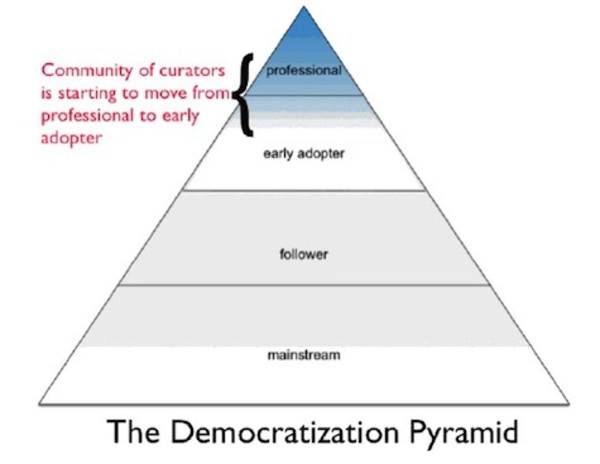Perhaps you won’t believe me since it’s my job to spread the gospel of curation as the Chief Evangelist of Pearltrees, but I think curation is here to stay. These are the reasons why I believe this is the case.

This year there has been a tremendous amount of buzz in Silicon Valley about curation. Magnify.net CEO Steven Rosenbaum recently published a book, Curation Nation that has sparked a tremendous amount of conversation on the topic. Likewise a post by Brian Solis has been retweeted thousands of times. My company, Pearltrees has just surpassed 100,000 curators and 10 million page views a month, and in the past two years nearly a dozen companies that incorporate digital curation into their models have launched.
Oliver Starr is the Chief Evangelist for Pearltrees. Formerly he was the first employee at TechCrunch and the founder of MobileCrunch. Prior to that Oliver founded and exited two other companies, one in biotech databases and the other in online sales.
With all the attention curation has suddenly received, people are probably wondering if this is just another fad or is it something bigger? Is curation something more important than just the flavor of the month. Is it something that’s going to have real sticking power? In short, is curation something that really merits our attention?
First, curation is one of the underlying principles of the Web. This was recently discussed in an excellent post on Silicon Valley Watcher by Patrice Lamothe called “The Web’s Third Frontier.” When Tim Berners Lee originally conceived of the Internet, he envisioned three principal functions:
- Allow anyone to access any type of document
- Allow everyone to disseminate his or her own documents
- Allow everyone to organize the entire collection of documents
Over the past 20 years what we’ve seen is the democratization of the first two principles above. Hypertext and Google made it possible for anyone to access any type of document. Platforms like WordPress, YouTube, Twitter and even Flickr have made it possible to disseminate documents. As Twitter co-founder Ev Williams said at last year’s Web 2.0 Summit, one of his overarching goals was to democratize publishing “by lowering the bar about as far as it could go”.
Secondly, we have very strong evidence that curation has begun a similar process towards democratization, and that what we are seeing now is an adoption curve similar to blogging. This has happened with Web 2.0 and it’s why you now have to deal with friend requests from Grandma.

The graphic above illustrates this process of democratization. At the apex of the pyramid you tend to have people that use a technology as part of what they do for a living. With each successive shift in the user base a broader audience begins to adopt that technology until, at the bottom of the pyramid, the technology has permeated a society.
So what is the evidence that this is starting to happen? Along with the rapid growth of our community, the composition of our user base has shifted. At first it was people that curate as part of their daily work: researchers that are curating content for a project, journalists that are using our tools for their work. Now it’s broader and more more representative of the early adopter crowd.
Here’s what our typical user looks like today: most likely educated, professional, an archivist at heart, at some point may have been a blogger. They’re “incidental altruists” – people that are happy to share what they’ve curated but aren’t going out of their way to build value for a community. In other words, people that are mainly curating for themselves but are happy if what they’ve done benefits others.
In recent months we have seen highly influential investors begin to focus on curation and also to make significant bets on the space.
These points all converge to give us a picture that we have crossed over from professional users to early adopters within the curation field.
Third, in recent months we have seen highly influential investors begin to focus on curation and also to make significant bets on the space. In fact, in a recent Huffington Post article on the topic, Steve Rosenbaum, the CEO of Magnify.net and one of the most outspoken proponents of the curation trend, quoted Russian mega-investor Yuri Milner as saying, “I think the next big theme is basically curation.”
Similarly, Fred Wilson, has written about the value of curation in social services. His contention is that curation improves the signal-to-noise ratio in social Web services that have become “messy and hard to navigate.” Yet another high-profile thinker and investor, Paul Kedrosky, contends that curation begat search which is being replaced once again by curation.
Clearly there are forces at play here – mainly curation gaining mindshare with investors, and their subsequent deployment of capital into the space – that are starting to provide the impetus for curation to truly take hold. Provided that these astute investors make their bets on the right entrepreneurs in this space, I believe it is likely that at least one of them will become the company Scoble suggests will result from capitalizing on the curation opportunity.
So is curation here to stay? I think it’s safe to say it is. Curation is part of the DNA of the Web from its very origin, we have strong evidence that curation is at the beginning of the democratization process, and investors are providing the capital to ensure that this process continues. Given these facts I’m confident that curation is not just the flavor of the month, but a rapidly growing trend that represents both a third phase of the Internet and a huge opportunity for entrepreneurs and investors.
Photo by ilco










